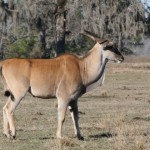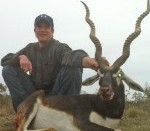
Eland Antelope are the world’s largest antelope breed weighing up to 2000 lbs. Males with horns ranging between 24″-30″ contact us for more info!

Eland Antelope are the world’s largest antelope breed weighing up to 2000 lbs. Males with horns ranging between 24″-30″ contact us for more info!
For the rest of the year we will be offering any size Axis, Fallow, or Blackbuck trophy for $2000. Bring a friend and make it $1800 for each trophy of any size! If you have any questions contact us by filling out the form.
“Whenever a firearm is involved with any activity, there is a potential for an accident to occur when the firearm is not handled responsibly. How to be a safe hunter is not something you learn once. Hunting safety should be an ongoing development of skills and attitude over the lifetime of the hunter.” -By Texas Parks and Wildlife

Blackbuck Antelope are among one of the smallest antelope species. Older males appear differently from that of females. As males age, their light coloration changes to dark brown, almost black, around 5 to 6 years of age. During breeding seasons male coats will turn to a darker color making them appear older than they really are. The females coat stays constantly tan with white along the belly. Male horns have a V shape overall, and each horn makes a corkscrew with rings. Horns anywhere in the 20″ range are considered great. The world record is 34.75″.

European Fallow have a large variation of coat patterns and color. There are four main color variations from almost black resembling the Sika deer to a orange color with spots resembling the Axis deer, a tan resembling the White-Tail and a solid white appearing almost albino. Fallow Deer with the antler length of 20″ are considered great trophies, and above 29″ is extraordinary. The world record is 37.66″. A palmation of 3.5″ or wider is great, but width can reach outstanding amounts such as 10″. There is always variation in shape in palmation, and is never exactly symmetrical and will usually not appear until the age of 3.

Axis Deer have a burnt orange coat with white spots resembling a young white tail; they also have a black streak running along their spine. Males and females have a white patch on their throat. Males have large antlers that grow upward, forking twice once at the base and again inside the main beams. Axis antlers are normally a six point. More than six would be considered atypical. Axis antlers are mostly seen in the 20″ range. Any in the 30″ range are considered great trophies, and if they reach 36″ they are extraordinary.